Research Centers and Labs
Igniting passion. Engineering the future. Making a difference.
At the School of Engineering, we focus on research for the common good. We develop real solutions that have a real impact on society.
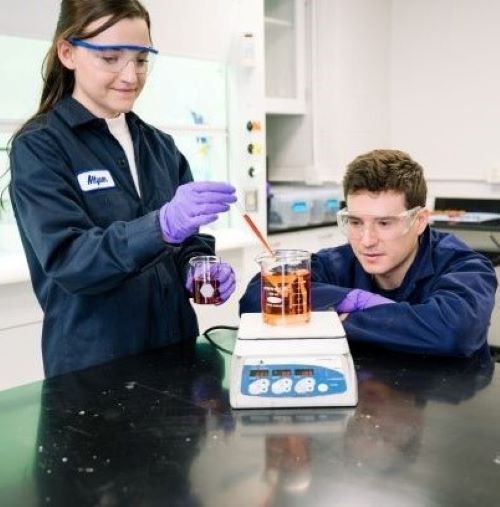
Department of Chemical and Materials Engineering
The Advanced Electronic Biosensor Fabrication Lab features scaled materials synthesis and high-speed fabrication tools for mass-production of adaptable electronic 2D sensor platforms suitable for rapid (30 second) and specific detection of viruses and biomarkers in biological samples. These tools include vapor phase deposition systems, high-speed patterning lasers, an inkjet printer for application of coatings for specific detection, an electronic probe station and high-throughput wireless data acquisition systems.
The Advanced Materials & Additive Manufacturing (AM&AM) Laboratory is dedicated to research in advanced materials development using various additive manufacturing techniques. The primary objective of our research lab is to develop high-performance polymer, ceramic, and metal-based matrix nanocomposites with improved mechanical, tribological, thermal, electrical, optical or magnetic properties tailored for specific applications. Equipped with diverse 3D printing technologies, our lab serves both research and teaching purposes. These advanced manufacturing technologies include laser powder bed fusion (LPBF), vat photopolymerization (VP), fused deposition modeling (FDM), direct ink writing (DIW) and inkjet printing. Utilizing these state-of-the-art 3D printing technologies, we aim to explore the inherent beauty and potential of materials, push the boundaries of material science and develop advanced materials with enhanced properties to address the needs of various applications.
In the Advanced Nanomaterials Laboratory at UD, we work at the rich interface of biomedical devices, drug delivery, next-generation quantum dot light emitting diodes, nano-enabled precision agriculture and nanotoxicology. We use novel nanochemistry approaches to engineer bio-inspired materials for applications in bioelectronics, point-of-care diagnostics, risk assessment, sustainable energy, and nanoagriculture. We also focus on theoretical investigation of key nanoscale material properties through our computational projects.
Learn more about the Advanced Nanomaterials Lab
Engineered 3D human tissue models have emerged as a powerful tool for the pharmaceutical industry, as well as in infectious disease and cancer research. The Biomatter Manipulation Technology Group (BMTG) is focused on integrating advances from multiple disciplines to develop new technologies to address challenges in human health and performance-related research. We develop, improve, and apply biomaterials, and biofabrication tools to create in vitro tissue models with advanced architectures, improved reproducibility, and reduced cost with the goal of accelerating bioscience research and medicine. We are developing novel biomaterials to support multiple 3D bioprinting technologies as well as novel bioreactor designs to aid in 3D tissue fabrication, maturation, and exposure to various and unique pathological challenges and pharmaceutical therapies.
Learn more about the Biomatter Manipulation Technologies Lab
The Carbon Research Lab is focused on the growth, fabrication and manufacturing of all kinds of nanomaterials with various chemical compositions, shapes and morphologies such as spherical, cylindrical, lamellar and undefined. Three methods of preparation of nanocomposites are available using wet chemistry, precipitation and/or chemical and physical vapor deposition. The lab contains state of the art equipment for materials processing control. At each stage of the process, materials are characterized using multiple microscopic and spectroscopic techniques. The Carbon Research Lab provides controlled conditions in which research experiments and measurement may be performed at multiple scales from macro to nanometric scale.
The Cellular Evaluation of Bioengineering Applications Lab merges chemical engineering foundation with both bioengineering and nanomaterial-bioeffects and has the central goal of bridging the in vitro – in vivo gap through the generation and implementation of enhanced, physiologically-relevant cellular-based. The first research goal is to design and generate enhanced in vitro models that retain the advantages of cell-based systems, but incorporate key physiological influences, including the inclusion of fluid dynamics, the generation of multicellular models, the replacement of cell culture medium with biological fluids and the utilization of three-dimensional (3D) growth scaffolds. The second research goal is to implement these enhanced models for safety and efficacy evaluations of emerging biomedical therapeutics. Endeavors have heavily focused on nanomaterial (NM) characterization and assessment, cancer therapeutic evaluation and evaluation of novel antibiotics.
The Molecular Simulations of Nanomaterial Surfaces Lab uses computational modeling to investigate the behavior of materials and interfaces at the molecular level. Problems such as these extend to many applications including reverse osmosis membranes and drug delivery. Molecular simulation allows us to access information that may not be possible in experiments and our goal is to use this to enable more efficient design of nanomaterials for specific materials science and biomedical applications.
The Nanoscale Engineered Materials Laboratory (NEMLab) research group is focused on understanding the behavior and assembly of functionalized nanoscale materials, with an emphasis on magnetic nanoparticles, and translating this knowledge onto practical macroscale engineering applications.
Learn more about the NEMLab
The University of Dayton Polymers and Composites Lab showcases several types of processing equipment to make polymer and fiber-reinforced polymer samples, as well as extensive characterization equipment. Our research revolves around the development and testing of new lightweight materials for aircraft and spacecraft applications, such as composites and adhesives. Additional focus is on improved flame retardants for these materials, which is a collaboration with the University of Dayton Research Institute (UDRI) and the University of Dayton Department of Chemistry and Department of Civil and Environmental Engineering and Engineering Mechanics. Dr. Klosterman works with students ranging from the undergraduate to doctoral levels to get hands-on experience in the lab, including materials preparation, processing and testing. The UD student chapter of SAMPE also utilizes this lab space each spring semester for the annual composite bridge building contest design competition.
Learn more about the PAC Lab
The major research and system development projects investigated by the Sarwan Sandhu Research Lab consist of flame speed on a porous fibrous bed, laser interferometric study of heat transfer in D.C. electric fields, emission of oxides of nitrogen from fluidized bed combustion of coal, thermodynamic simulation as well as heat and mass transfer analysis of an ideal hydrogen/oxygen fuel cell, carbon-carbon surface oxidation protection, chemical kinetics model of the pyrolysis of carbon-carbon composites and the various other research projects in the areas of fuel cells and lithium-ion cells/batteries. Dr. Sandhu has been conducting both the theoretical and experimental investigations. Since 1998, the experimental research work required for the validation of theoretical models is conducted in collaboration with Dr. Joseph P. Fellner, WPAFB.
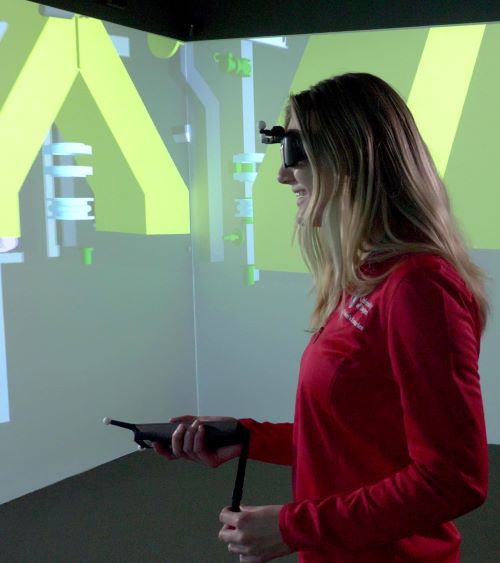
Department of Civil and Environmental Engineering and Engineering Mechanics
The Center for Flame Retardant Materials Science is a collaboration between the University of Dayton's chemical and material engineering, civil and environmental engineering, chemistry, and the Research Institute's (UDRI) power and energy division that focuses on advancing basic and applied chemical and material sciences to deliver new and improved fire safe solutions by working with academic, government and industrial partners in the U.S. and abroad.
Learn more about the Center for Flame Retardant Materials Science
When a building is built, it's too late to change the placement of something. But the Greg and Annie Stevens Intelligent Infrastructure Engineering Lab brings buildings to life before dirt is turned, allowing engineers to see if the way it's intended to be built is the way it should be. Load blueprints or any other computer-aided design drawings, or sensor data into the system, which then goes beyond photo mockups by creating a virtual facility in which users can float up, down, side-to-side, through walls, onto the roof or into the basement similar to 360-degree theaters.
Learn more about the Greg and Annie Stevens Intelligent Infrastructure Engineering Lab
The Transportation Engineering Lab provides necessary equipment and space for traffic control and analysis, system planning, model development and testing, intelligent transportation system evaluation, highway safety assessment and crash data analysis. University of Dayton students work on challenging research projects that focus on solving, evaluating, or improving local, regional or statewide transportation-related issues.
Learn more about the Transportation Engineering Lab
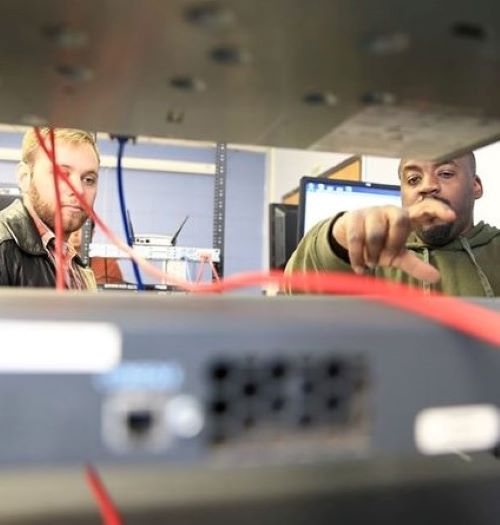
Department of Electrical and Computer Engineering
The Applied Sensing Laboratory (ASL) was created as a center for applied remote sensing research, with a particular focus on the research and development of signal and image processing, computer vision, and pattern recognition algorithms. The ASL is particularly concerned with applied remote sensing in the electro-optical and infrared (EO-IR) regions of the electromagnetic spectrum, with a specific focus on student research in the areas of visible, infrared (IR), hyperspectral (HSI), polarimetric (PI), spectro-polarimetric, 3D imaging and data fusion. These skills are highly desirable within industry and will particularly impact engineering students who seek employment within the local Dayton Air Force community at Wright Patterson Air Force Base and Department of Defense in general.
Learn more about the ASL
The Biomedical Engineering & Additive Mechatronics (BEAM) Laboratory is dedicated to research in biomedical engineering, medical imaging/healthcare electronics and additive manufacturing techniques for medicine and 3D printed electronics. The lab features a variety of bioinstrumentation and equipment utilized for patient diagnostics in healthcare, including a telehealth virtual patient care platform received from Premier Health Network for collaborative clinical telemetry research. The lab also features a Fusion3 F410 Fused Deposition Modeling (FDM) 3D Printer, a FormLabs Form2 stereolithography (SLA) 3D Printer, benchtop test and measurement electronics, Bantam Tools Othermill Pro PCB milling machine, desktop computers, and associated computer software for circuit design/analysis, medical imaging and 3D CAD design. In addition, the BEAM Lab has access to both commercial grade EOS M290 selective laser melting (SLM) and open architecture SLM metal 3D printers through collaborative research efforts with the University of Dayton Research Institute (UDRI).
Researchers at the University of Dayton, with a combined 15 patents and more than 600 publications, collectively established the Center of Excellence for Thin-Film Research and Surface Engineering (CETRASE) to focus on improvements of sensors, electronics, electro-optics and energy systems.
Learn more about CETRASE
The Integrated Microsystems Lab pursues pioneering engineering and technology research and development to translate into commercial products as well as provide resources to industries and train highly-skilled engineers, scientists and technicians in micro- to nano-scale electronics, fabrication, integration and packaging.
Learn more about the Integrated Microsystems Lab
The Intelligent Signal Systems Laboratory (ISSL) at the University of Dayton is a world class research laboratory in image processing and computer vision. Our research focuses on three areas: physical and statistical modeling of image sensors, algorithmic development for exploitation of image data, and making meaningful inferences on the observed scene. Research at ISSL is aimed at understanding the increasingly large role that signal systems play in the real-world. We connect the applied design efforts with the first principle ideas of mathematics and statistics to enable new capabilities in image processing and computer vision.
Learn more about ISSL
The Motoman Robotics Laboratory research focuses on visual servoing, metrology and calibration, real-time control and other topics relevant to industrial robotics. The lab functions as the centerpiece of the Robotics Concentration in the electrical and computer engineering curriculum.
Learn more about the Motoman Robotics Lab
One of the world's most unique radar labs. While robots are rotating in the space, the custom-made eight-channel Agilent Network Analyzer collects data. Mumma Radar Lab has been designated as a Center of Excellence in Distributed Sensing and Multistatic Radar.
Learn more about the Mumma Radar Lab
The Parallel Cognitive Systems Lab is specialized in AI applications and hardware. In AI applications, the lab is examining: deep learning algorithm and applications (medical imaging, image understanding and enhancement, cyber security), parallel algorithms for cognitive agents (with AFRL), spiking neural network algorithms for cognitive agents (with AFRL), and application development for spiking neural processors: Intel Loihi and IBM TrueNorth.
Learn more about the Parallel Cognitive Systems Lab
The Signal and Image Processing Laboratory conducts research on a wide range of topics in the areas of digital signal and image processing. Some focus areas include super-resolution enhancement of digital video, medical image processing, image detector nonuniformity correction, atmospheric turbulence modeling and mitigation, and hyperspectral image processing.
Learn more about the Signal and Image Processing Lab
UDRI conducts both fundamental and applied research in battery and battery system technologies. Our groundbreaking work includes thin film coating; processing (small to large format); custom li-ion design, fabrication and testing; and independent evaluation of batteries and battery system technologies for application in wearables, drones, electronics, vehicles, space equipment, and much more.
Learn more about the S2BIS Lab
The SPEED Lab focuses on research in emerging applications utilizing high power or high frequency wide bandgap devices e.g. SiC or GaN; high density power conversion using innovative topologies for data center, solar farm, and transportation electrification; health monitoring and lifetime prediction of power converters; smart grid integration with renewable energy sources; LED driving; power conversion topology innovations including Z-source, multilevel, switched-capacitor, and soft-switching resonant converters, and intelligent gate drive for IGBT/SiC power modules.
Learn more about the SPEED Lab
The mission of the Vision Lab is to invent new technologies for sensor-based information extraction and automatic decision-making and to train undergraduate and graduate students to become outstanding candidates to learn, lead and serve in the areas of machine intelligence and autonomous systems.
Learn more about the Vision Lab
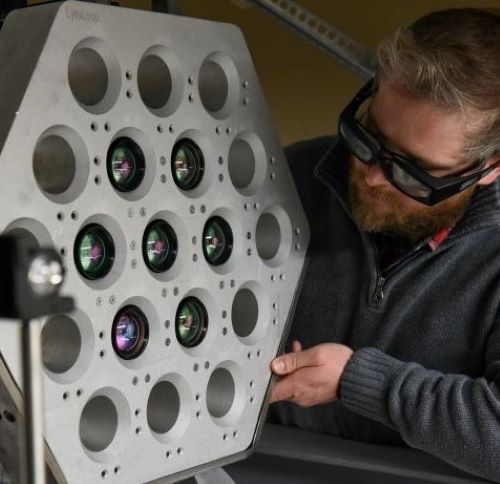
Department of Electro-Optics and Photonics
The Hybrid Integrated Photonics Sensors Lab is engaged in state-of-the-art research integrating hybrid materials with large scale silicon photonics circuits for novel applications in computing, communications and chem-bio sensing/spectroscopy. In sensing and spectroscopy, our research aims to achieve low-cost sensors for environmental pollution monitoring and healthcare diagnostics. In computing, our research aims to achieve energy-efficient switches and modulators with hybrid materials. Devices studied in our group can also have potential applications in quantum photonic computing.
Learn more about the Hybrid Integrated Photonics Sensors Lab
LOCI offers laser radar curriculum and consolidates the brainpower of the region's lidar researchers — instructors from the University of Dayton and the Air Force Institute of Technology.
Learn more about LOCI
The primary focus of the Intelligent Optics Lab is on the areas of controllable and adaptive optical systems as well as optical wave propagation through the atmosphere. The research and development team specializes in the development of intelligent optics laser and sensing systems with improved performance in harsh operating conditions.
Learn more about the Intelligent Optics Lab
The Nano-Fab Lab focuses on photonic and electronic device fabrication and optical thin film development. Housed inside a class 100 cleanroom, this facility has all of the capabilities to go from raw substrates to completely packaged devices. Capabilities include advanced thin film deposition, metrology, photolithography and chemical and plasma etching.
Learn more about the Nano-Fab Lab
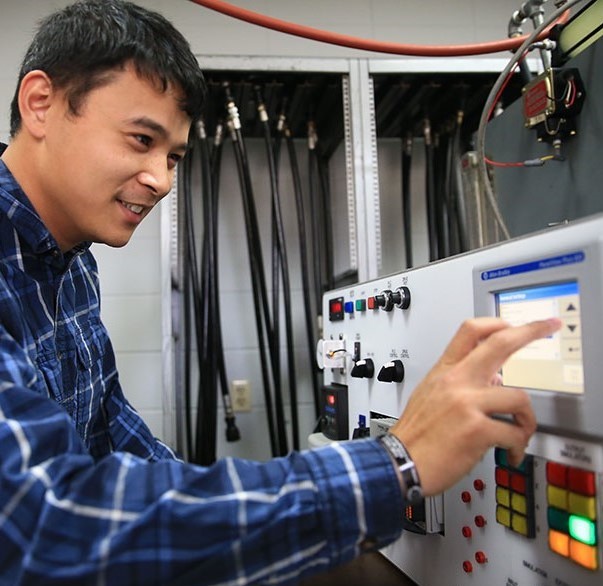
Department of Engineering Management, Systems and Technology
The Human Performance and Cognition Lab is a pioneering research facility dedicated to the investigation of mental workload analysis. Leveraging eye-tracking technology, our lab seeks to push the boundaries of human cognition and productivity in order to elevate human performance. Our overarching mission is to expand the possibilities of human performance and well-being, whether through optimizing work systems or enhancing educational experiences for both our faculty and students. Through a combination of educational initiatives, workshops and outreach programs, we are committed to disseminating our knowledge and fostering a deeper comprehension of mental workload analysis. Our goal is to contribute to the advancement of work design and ultimately improve the quality of life for the human-in-the-loop in the military and civilian sectors.
The Nano-Energy Composites Synthesis and Applications Lab has been established through an equipment donation through the United States Air Force Educational Partnership Agreement (EPA) between the Air Force Research Laboratory Aerospace Systems Directorate and the University of Dayton. The equipment has been provided to establish a Nano-Energy Composites Synthesis and Applications teaching laboratory. The laboratory will serve as a cornerstone capability for educational materials research within the Department of Engineering Management, Systems and Technology, specifically in support of the Mechanical Engineering Technology program. Using the proposed synthesis equipment, students and faculty can explore the production of energetic composites and carbon-based materials. Using the proposed analysis equipment, students and faculty can explore the testing and measuring of various material properties related to energy storage and conversion, and photo and electro catalytic response. Combined with existing materials characterization equipment and device assembly tools, students and faculty can explore the application of their composites, making the proposed equipment a vital component of teaching in the area of
materials processes.
We are at the cusp of a new soft electronics revolution as we see the development of flexible and conformal electronic devices, like batteries, displays, printed circuit boards, and solar cells. This shift from rigid toward soft electronics makes the integration of these systems into everyday life more natural and seamless, particularly in wearable electronics. Next generation wearables have the potential to impact a vast array of industries, including sensors and communication systems for healthcare, athletics, first responders and military biometric data monitoring, as well as haptic feedback for virtual and augmented reality applications. Smart clothing that incorporates electronics directly into the textile requires a soft, electrically conductive material that can withstand both flexing and stretching. The Wearable and Tunable Systems Lab is studying a state-of-the-art conductive ink based on a liquid metal alloy of gallium and indium that was developed at the Air Force Research Lab (AFRL). This room-temperature and non-toxic liquid metal ink shows exceptional tolerance to stretching and flexing, allowing traces for data and power to be incorporated directly into the textiles.
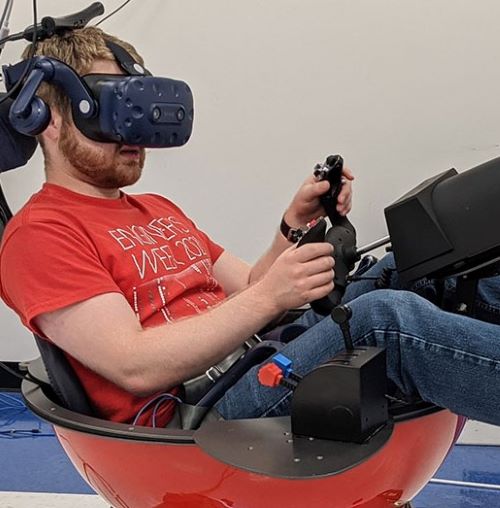
Department of Mechanical and Aerospace Engineering
The research interests of the Behavior of Advanced Materials and Structures (BAMS) Laboratory lie at the intersection of mechanics, materials, and computational modeling. The BAMS Lab uses the principles of continuum mechanics together with carefully-conducted experiments and novel computational approaches to develop innovative multi-physics predictive models for understanding the deformation and failure of a variety of advanced materials, from dielectric elastomers to additively manufactured soft materials. In so doing, we aim to develop robust predictive models – grounded in sound experimental data – that facilitate the design and optimization of novel materials and structures, and artfully link processing to performance.
Learn more about the BAMS Lab
The goal of the Building Energy Center (UD-BEC) is to help improve building performance and energy efficiency while educating energy-efficiency engineers and advancing the science of building energy performance.
Learn more about the Building Energy Center
The DaTA Lab pursues engineering solutions to real problems through application of the thermal sciences. Our facility is a place where faculty, graduate students and undergraduate students work together to create prototypes, experiments and mathematical models of energy systems. Applications we have explored include: concentrating solar thermal systems, hypersonic vehicles, spacecraft thermal control, photovoltaic system optimization, solar thermal spacecraft propulsion, building energy conservation, solar desalination, biochar production, geothermal heat exchangers and radiative fin optimization.
Learn more about the DaTA Lab
The primary goal of the DIMLab is to create, design, build, and test novel machines and mechanisms for a variety of applications while generating the theory that supports these innovations. Current research projects involve shape-changing rigid-body mechanisms,
spatial morphometric analysis and statically equivalent serial chains.
Learn more about the DIMLab
Our research has the potential to transform the clinical assessment and treatment of balance, gait and mobility problems. More specifically, the research we do is intended to better identify factors that contribute to postural control, mobility and fall incidence, particularly in individuals who may be at especially high risk for these problems because of disabilities and other underlying conditions. We have received considerable attention for our work in the areas of fall prevention in older adults with dementia and in the evaluation of sensory integration therapy in children with autism.
Learn more about the Engineering Wellness Through Biomechanics Lab
The EMPOWER Lab focuses on research in posture, balance, neuro-muscular control, computational modeling and rehabilitation. The lab includes world-class equipment, including 3D motion cameras, wearable motion measurement sensors, a force-measuring treadmill, virtual reality systems, and a Caplex System, which provides a central platform to emulate wearable devices such as exoskeletons and prosthetics.
The University of Dayton Industrial Assessment Center (UD-IAC) conducts free energy, waste and production assessments for small- to mid-sized industries and is funded by the U.S. Department of Energy. In a typical year, the center saves companies the equivalent electricity use of 1,300 houses and the equivalent natural gas use of 280 houses.
Learn more about the Industrial Assessment Center
The Low-Speed Wind Tunnel Lab is a research and teaching hub for our engineering students to explore ways to improve aerodynamic efficiency. This exploration is achieved through a mélange of aerodynamic techniques including: force-based experiments, pressure wake surveys, optical flow diagnostic techniques, hot-wire anemometry and flow visualization. Apart from research projects performed by graduate students, the wind tunnel has supported innumerable class and senior capstone design projects.
Learn more about the Low-Speed Wind Tunnel Lab
The Merlin Flight Simulator Lab comprises the flagship 521 engineering flight simulator and instructor station, a UAV desktop station enabling flight in the same airspace as the 521, and an air traffic control station. The simulator takes the outputs from a conceptual aircraft sizing details from existing aircraft and uses that information to model the handling characteristics. Students easily enter their geometric, aerodynamic, weight and propulsion characteristics through an easy-to-use graphical user interface. Once entered, the details are used in a physics-based flight mechanics module to recreate an accurate representation of how their air vehicles would fly. Included in the physics modeled is non-linear aerodynamic behavior based on real input airfoil performance data, thrust lapse with altitude, of lift shift in the transonic region, of gravity shift with dropped/deployed payload, basic aeroelastic effects and more.
Learn more about the Merlin Flight Simulator Lab
The Smart Manufacturing Advancement and Logistics Technology (SMALT) Laboratory at the University of Dayton is dedicated to pioneering advancements in additive manufacturing. This endeavor seeks to enhance the quality of manufactured components, minimize energy utilization and enable the production of complex parts. The laboratory's vision encompasses the integration of sensor data derived from diverse modalities (infrared camera, ultrasound, x-ray, electric field), coupled with advanced computational methods. This integration aims to create a real-time digital response of the manufacturing process, thereby facilitating comprehensive control over the part's quality, reliability, and sustainability. Further emphasizing our commitment, the SMALT Laboratory ardently focuses on high-performance computation, deep learning and data analysis involving sensor data interpretation. This multifaceted approach is pivotal in refining the manufacturing process, contributing significantly to a more sustainable, energy-efficient manufacturing technique that has the potential to replace the conventional manufacturing process.
Learn more about the SMALT Lab
The Water Tunnel Lab is a recent addition to the aero labs in the School of Engineering. The water tunnel offers a range of Reynolds numbers to test, which is far below what the Low-Speed Wind Tunnel Lab can offer. The water tunnel is predominantly a research facility established in collaboration with AFRL and fitted with equipment to design, develop, and test closed loop control system architectures to mitigate unsteady and gust loads on wings. The closed loop control system developed in the lab allows for lift tracking and control over a range of reduced frequencies and amplitudes, especially when subjected to external discrete and periodic disturbances. It also allows testing of many of the existing unsteady models for its robustness and accuracy.
